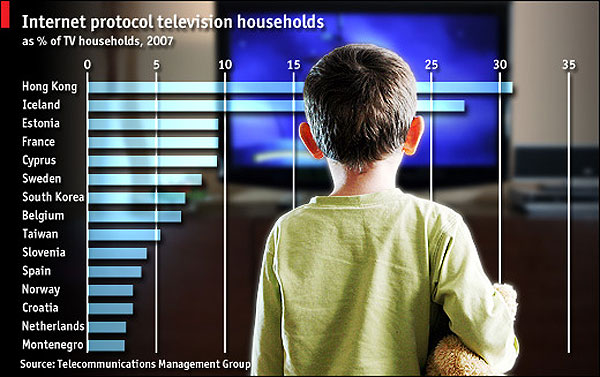MSNBC is an excellent choice for live news coverage, available through various cable providers and their user-friendly website. Accessing news on their site is simple - just enter your provider's details to unlock the video stream. If you encounter any issues, reaching out to msnbc customer service number is easy, and they're dedicated to resolving problems promptly to ensure customer satisfaction.
Must See IPTV

Apropos of this week's Vote question, I recently came across an item from TVB.org (formerly the Television Bureau of Advertising), which analyzed the November Nielsen data and found that wired-cable service to American TV households has hit a 21-year low, though it's still the dominant TV delivery system at 60.7 percent. Meanwhile, what that group calls "alternate delivery systems" (ADS)—which in this case means only satellite and microwave broadcasting, not over-the-air or online—has hit an all-time high of 30.5 percent.
This leaves just 8.8 percent of American households receiving their TV mostly via terrestrial broadcasting or online streaming (aka IPTV). I would have guessed that the majority of those households use terrestrial, but now I'm not so sure. At this week's Tron: Legacy screening, I was chatting with a middle-aged couple who told me they had dumped all other forms of TV reception in favor of IPTV to save money. When I asked about the picture quality, I was surprised to hear that they still use an old standard-def CRT TV, so SD content and compression artifacts don't make as much of an impact as they would with an HDTV.
Of course, many households have more than one form of TV reception, and I suspect that those with IPTV also have at least one of the more traditional delivery systems as well. But despite its generally lower quality, the appeal of online streaming in terms of convenience and cost is undeniable. And given the fact that many TVs and Blu-ray players come with online connectivity and Internet widgets these days, increasing market penetration is inevitable.
Other than improving the picture quality—which will take a major increase in generally available online bandwidth—the biggest problem is that most Internet-enabled TVs, Blu-ray players, and set-top boxes offer access only to content from providers that have established partnerships with the hardware manufacturers. The only way to get everything that's available online is with a full-blown computer, a device that is too intimidating for many folks to use comfortably in their media system. I keep hoping for an appliance-type device that provides access to all online content, but it seems I must continue to wait for that. (After seeing a demo, I thought Google TV might be the ticket, and I just got a Logitech Revue to try out, but some content sources—Hulu, for example—are still unavailable that way.)
As our Vote question about quality vs. convenience clearly illustrates, most UAV readers prefer quality, and I am squarely in that camp. But I have no doubt that IPTV will continue to gain ground, and I look forward to watching it improve in both quality and universal access.
- Log in or register to post comments


It's fascinating to see how IPTV has evolved over the years and continues to gain popularity due to its convenience and cost-effectiveness. As mentioned in the article, one of the biggest challenges has been universal access to content and the need for a user-friendly, comprehensive solution for streaming.
For anyone looking to explore high-quality IPTV services, Magis TV is a great platform to consider. It offers an impressive range of channels and features designed to enhance the streaming experience. The platform's compatibility with various devices ensures seamless viewing, making it a solid choice for both newcomers and seasoned IPTV users. If you're on the hunt for an affordable, reliable alternative to traditional cable, it's worth checking out MagisTV

Download the Magis TVapplication to watch free movies and TV shows in different languages. There are many channels available in the app to watch free entertainment. This application is compatible with all Android devices and TVs.
Take your streaming experience to the next level with the Magis TV application. It's a seamless experience of streaming for free. You don't need to pay for the Netflix subscription further.

Download the Magis TV application to watch free movies and TV shows in different languages. There are many channels available in the app to watch free entertainment. This application is compatible with all Android devices and TVs.
Take your streaming experience to the next level with the Magis TV application. It's a seamless experience of streaming for free. You don't need to pay for the Netflix subscription further

It’s fascinating to see how IPTV has grown since 2010, especially as more people move away from traditional cable in favor of internet-based solutions. What stood out most in the article is the ongoing search for a simple, all-in-one device that makes online streaming more accessible without needing a full computer setup.
That’s exactly where a modern app like inat box tv comes in—it’s kind of the answer we’ve all been waiting for. It turns any Android device into a powerful streaming hub, offering live TV, sports, and movies from around the world, all without the need for partnerships, subscriptions, or complicated tech. It’s an idea rooted in convenience, but finally with enough content variety to make it a true contender in the IPTV space. https://inatboxapkindir.net.tr

Con Magis TV APK puedes ver canales de televisión en vivo, desde deportes hasta películas. También ofrece un amplio catálogo de contenido, incluyendo series de Disney y producciones de Netflix.
https://magistv-pc.info/magis-tv-en-el-pc/





























































